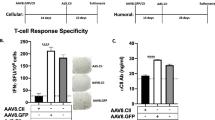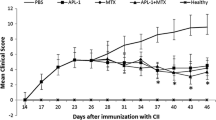Abstract
Rheumatoid arthritis (RA) is a systemic autoimmune disease mediated by T cells. Collagen type II (CII) is one of the autoantigens associated with RA. CII263-272 is a predominant CII antigenic peptide that can induce T-cell activation upon binding to MHC and interaction with the appropriate T-cell receptor (TCR). Altered CII263-272 peptides with substitution of specific amino acids could bind to RA-associated HLA-DR4/1 with no T cell stimulating effects and could inhibit T cell activation in RA. We performed this study to evaluate the effect of mucosal administration and to explore the mechanism of the inhibitory effect of altered CII263-272 peptide (267Q → A, 270K → A and 271G → A) on collagen induced arthritis (CIA). CIA was induced in Lewis rats by immunization with bovine CII. Altered CII263-272 peptide was given intranasally beginning from arthritis onset. Wild CII263-272 peptide or PBS was administered as controls. Therapeutic effects were evaluated by arthritis scores, body weight change, and joint pathologic scores. The anti-CII antibody and its subtypes and the cytokines, IFN-γ, IL-10, and IL-17 were measured with ELISA. Foxp3+CD4+CD25+ regulatory T cell induction was assessed by FACS analysis. Following treatment with the altered CII263-272 peptide, arthiritis scores were reduced and body weight was increased. The altered CII263-272 peptide could retard the histologic lesion of the joints. The titers of anti-CII antibodies IgG2a in altered CII263-272 peptide treated rats decreased markedly compared to PBS-treated rats. The serum levels of IFN-γ in rats treated with altered peptide was lower than that of rats treated with wild CII263-272 peptide and PBS. No differences were observed in the levels of serum IL-10 among the three groups. The altered CII263-272 peptide could decrease serum level of IL-17 and increase peripheral Foxp3+CD4+CD25+ T cells at early stage of CIA. Mucosal administration of altered CII263-272 peptide could effectively inhibit the progression of CIA. Altered CII263-272 peptide could suppress Th17 cells and expand regulatory T cells in the early stage of the disease. The IgG2a subtype of anti-CII antibodies and IFN-γ were reduced and in vivo Th1 responses were inhibited as a result of altered CII peptide treatment. Altered CII peptide is likely therapeutic in RA.






Similar content being viewed by others
References
VanderBorght A, Geusens P, Raus J, Stinissen P (2001) The autoimmune pathogenesis of rheumatoid arthritis: role of autoreactive T cells and immunotherapies. Semin Arthritis Rheum 31:160–175. doi:10.1053/sarh.2001.27736
Myers LK, Sakurai Y, Tang B, He X, Rosloniec EF, Stuart JM et al (2002) Peptide-induced suppression of collagen-induced arthritis in HLA-DR1 transgenic mice. Arthritis Rheum 46:3369–3377. doi:10.1002/art.10687
Zhou Q, Cheng YJ, Lü H, Zhou WH, Li ZG (2003) Inhibition of T cell activation with HLA-DR1/DR4 restricted non-T cell recognizing peptides. Hum Immunol 64:857–865. doi:10.1016/S0198-8859(03)00143-5
Cheng YJ, Zhou Q, Li ZG (2005) The inhibitory effect of altered collagen II peptide on HLA-RB1-restricted T cell activation. Scand J Immunol 61:260–265. doi:10.1111/j.1365-3083.2005.01553.x
Li R, Li X, Li ZG (2006) Altered collagen II peptides inhibited T-cell activation in rheumatoid arthritis. Clin Immunol 118:317–233. doi:10.1016/j.clim.2005.09.020
Ohnishi Y, Tsutsumi A, Matsumoto I, Goto D, Ito S, Kuwana M et al (2006) Altered peptide ligands control type II collagen-reactive T cells from rheumatoid arthritis patients. Mod Rheumatol 16:226–228. doi:10.1007/s10165-006-0495-1
Li R, Li X, Li P, Yao ZQ, Guo JL, Li ZG (2006) Effect of multiple amino acid substitutions of collagen II 263–272 on collagen-induced arthritis. Beijing Da Xue Xue Bao 38:360–364
Yao ZQ, Li R, Li ZG (2007) A triple altered collagen II peptide with consecutive substitutions of TCR contacting residues inhibits collagen-induced arthritis. Ann Rheum Dis 66:423–424. doi:10.1136/ard.2006.057927
Myers LK, Sakurai Y, Rosloniec EF, Stuart JM, Kang AH (2004) An analog peptide that suppresses collagen-induced arthritis. Am J Med Sci 327:212–216. doi:10.1097/00000441-200404000-00007
Sakurai Y, Brand DD, Tang B, Rosloniec EF, Stuart JM, Kang AH, et al. (2006) Analog peptides of type II collagen can suppress arthritis in HLA-DR4 (DRB1*0401) transgenic mice. Arthritis Res Ther 8:R150. doi:10.1186/ar2043
Waksman Y, Friedman HA (1996) Therapeutic effects of estradiol benzoate on development of collagen-induced arthritis (CIA) in the Lewis rat are mediated via suppression of the humoral response against denatured collagen type II (CII). Clin Exp Immunol 103:376–383
Kim KS, Choi YH, Kim KH, Lee YC, Kim CH, Moon SH, Kang SG (2004) Park YG: Protective and anti-arthritic effects of deer antler aqua-acupuncture (DAA), inhibiting dihydroorotate dehydrogenase, on phosphate ions mediated chondrocyte apoptosis and rat collagen-induced arthritis. Int Immuno pharma 4:963–973
Nishikawa M, Myoui A, Tomita T, Takahi K, Nampei A, Yoshikawa H (2003) Prevention of the onset and progression of collagen-induced arthritis in rats by the potent p38 mitogen-activated protein kinase inhibitor FR167653. Arthritis Rheum 48:2670–2681. doi:10.1002/art.11227
Bielekova B, Martin R (2001) Antigen-specific immunomodulation via altered peptide ligands. J Mol Med 79:552–565. doi:10.1007/s001090100259
Brocke S, Gijbels K, Allegretta M, Ferber I, Piercy C, Blankenstein T et al (1996) Treatment of experimental encephalomyelitis with a peptide analogue of myelin basic protein. Nature 379:343–346. doi:10.1038/379343a0
Santambrogio L, Lees MB, Sobel RA (1998) Altered peptide ligand modulation of experimental allergic encephalomyelitis: immune responses within the CNS. J Neuroimmunol 81:1–13. doi:10.1016/S0165-5728(97)00138-0
Alleva DG, Gaur A, Jin L, Wegmann D, Gottlieb PA, Pahuja A et al (2002) Immunological characterization and therapeutic activity of an altered-peptide ligand, NBI-6024, based on the immunodominant type 1 diabetes autoantigen insulin B-chain (9–23) peptide. Diabetes 51:2126–2134. doi:10.2337/diabetes.51.7.2126
Penzotti JE, Nepom GT, Lybrand TP (1997) Use of T cell receptor/HLA-DRB1*04 molecular modeling to predict site-specific interactions for the DR shared epitope associated with rheumatoid arthritis. Arthritis Rheum 40:1316–1326
Prakken BJ, Roord S, van Kooten PJ, Wagenaar JP, van Eden W, Albani S et al (2002) Inhibition of adjuvant-induced arthritis by interleukin-10-driven regulatory cells induced via nasal administration of a peptide analog of an arthritis-related heat-shock protein 60 T cell epitope. Arthritis Rheum 46:1937–1946. doi:10.1002/art.10366
Wu HY, Ward FJ, Staines NA (2002) Histone peptide-induced nasal tolerance: suppression of murine lupus. J Immunol 169:1126–1134
Shen CR, Youssef AR, Devine A, Bowie L, Hall AM, Wraith DC et al (2003) Peptides containing a dominant T-cell epitope from red cell band 3 have in vivo immunomodulatory properties in NZB mice with autoimmune hemolytic anemia. Blood 102:3800–3806. doi:10.1182/blood-2002-07-2125
Harrington LE, Hatton RD, Mangan PR, Turner H, Murphy TL, Murphy KM et al (2005) Interleukin 17-producing CD4 + effector T cells develop via a lineage distinct from the T helper type 1 and 2 lineages. Nat Immunol 6:1123–1132. doi:10.1038/ni1254
Park H, Li Z, Yang XO, Chang SH, Nurieva R, Wang YH et al (2005) A distinct lineage of CD4 T cells regulate tissue inflammation by producing interleukin 17. Nat Immunol 6:1133–1141. doi:10.1038/ni1261
Chabaud M, Durand JM, Buchs N, Fossiez F, Page G, Frappart L et al (1999) Human interleukin-17: A T cell-derived proinflammatory cytokine produced by the rheumatoid synovium. Arthritis Rheum 42:963–970. doi:10.1002/1529-0131(199905)42:5<963::AID-ANR15>3.0.CO;2-E
LeGrand A, Fermor B, Fink C, Pisetsky DS, Weinberg JB, Vail TP et al (2001) Interleukin-1, tumor necrosis factor alpha, and interleukin-17 synergistically up-regulate nitric oxide and prostaglandin E2 production in explants of human osteoarthritic knee menisci. Arthritis Rheum 44:2078–2083. doi:10.1002/1529-0131(200109)44:9<2078::AID-ART358>3.0.CO;2-J
Jovanovic DV, Martel-Pelletier J, Di Battista JA, Mineau F, Jolicoeur FC, Benderdour M et al (2000) Stimulation of 92-kd gelatinase (matrix metalloproteinase 9) production by interleukin-17 in humanmonocyte/macrophages: a possible role in rheumatoid arthritis. Arthritis Rheum 43:1134–1144. doi:10.1002/1529-0131(200005)43:5<1134::AID-ANR24>3.0.CO;2-#
Chabaud M, Garnero P, Dayer JM, Guerne PA, Fossiez F, Miossec P (2000) Contribution of interleukin 17 to synovium matrix destruction in rheumatoid arthritis. Cytokine 12:1092–1099. doi:10.1006/cyto.2000.0681
Stamp LK, James MJ, Cleland LG (2004) Interleukin-17: the missing link between T-cell accumulation and effector cell actions in rheumatoid arthritis? Immunol Cell Biol 82:1–9. doi:10.1111/j.1440-1711.2004.01212.x
Jovanovic DV, Di Battista JA, Martel-Pelletier J, Jolicoeur FC, He Y, Zhang M et al (1998) IL-17 stimulates the production and expression of proinflammatory cytokines, IL-1β and TNF-α, by human macrophages. J Immunol 160:3513–3521
Lubberts E, Joosten LA, van de Loo FA, Schwarzenberger P, Kolls J, van den Berg WB (2002) Overexpression of IL-17 in the knee joint of collagen type II immunized mice promotes collagen arthritis and aggravates joint destruction. Inflamm Res 51:102–104. doi:10.1007/BF02684010
Bush KA, Farmer KM, Walker JS, Kirkham BW (2002) Reduction of joint inflammation and bone erosion in rat adjuvant arthritis by treatment with interleukin-17 receptor IgG1 Fc fusion protein. Arthritis Rheum 46:802–805. doi:10.1002/art.10173
Nakae S, Nambu A, Sudo K, Iwakura Y (2003) Suppression of Immune Induction of collagen-Induced Arthritis in IL-17-Deficient Mice. J Immunol 171:6173–6177
Levings MK, Allan S, d’Hennezel E, Piccirillo CA (2006) Functional dynamics of naturally occurring regulatory T cells in health and autoimmunity. Adv Immunol 92:119–155. doi:10.1016/S0065-2776(06)92003-3
Tang Q, Bluestone JA (2006) Regulatory T-cell physiology and application to treat autoimmunity. Immunol Rev 212:217–237. doi:10.1111/j.0105-2896.2006.00421.x
Li P, Bi LQ, Li ZG (2006) Foxp3 expression of regulatory T cells in rheumatoid arthritis. Chin J Immunol 22:268–271
Ehrenstein MR, Evans JG, Singh A, Moore S, Warnes G, Isenberg DA et al (2004) Compromised function of regulatory T cells in rheumatoid arthritis and reversal by anti-TNFα therapy. J Exp Med 200:277–285. doi:10.1084/jem.20040165
Ben-David H, Sela M, Mozes E (2005) Down-regulation of myasthenogenic T cell responses by a dual altered peptide ligand via CD4+CD25+-regulated events leading to apoptosis. Proc Natl Acad Sci USA 102:2028–2033. doi:10.1073/pnas.0409549102
Berner B, Akça D, Jung T, Muller GA, Reuss-Borst MA (2000) Analysis of Th1 and Th2 cytokines expressing CD4+ and CD8+ T cells in rheumatoid arthritis by flow cytometry. J Rheumatol 27:1128–1135
Mosmann TR, Coffman RL (1989) TH1 and TH2 cells: different patterns of lymphokine secretion lead to different functional properties. Annu Rev Immunol 7:145–173. doi:10.1146/annurev.iy.07.040189.001045
Mukherjee P, Wu B, Mayton L, Kim SH, Robbins PD, Wooley PH (2003) TNF receptor gene therapy results in suppression of IgG2a anticollagen antibody in collagen induced arthritis. Ann Rheum Dis 62:707–714. doi:10.1136/ard.62.8.707
Acknowledgments
This work was partially supported by grants from the National Natural Science Foundation of China (No.30671933 and No.30430290).
Conflict of interest statement
The authors declare that they have no competing interests.
Author information
Authors and Affiliations
Corresponding author
Additional information
ZJX, carried out the experiments and drafted the manuscript. HJ, SJX and LL performed the experiments in coordination. LR and LZG provided experimental design and supervision. All authors read and approved the final manuscript.
Rights and permissions
About this article
Cite this article
Zhao, J., Li, R., He, J. et al. Mucosal administration of an altered CII263-272 peptide inhibits collagen-induced arthritis by suppression of Th1/Th17 cells and expansion of regulatory T cells. Rheumatol Int 29, 9–16 (2008). https://doi.org/10.1007/s00296-008-0634-4
Received:
Accepted:
Published:
Issue Date:
DOI: https://doi.org/10.1007/s00296-008-0634-4




